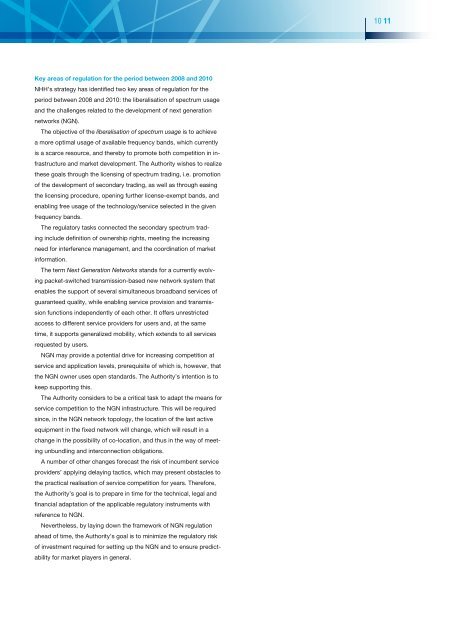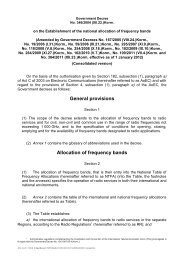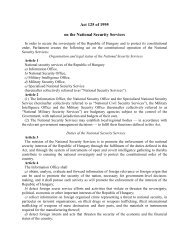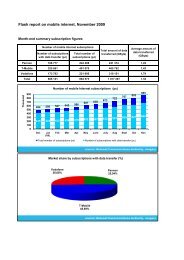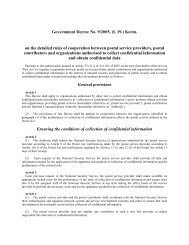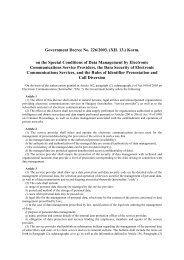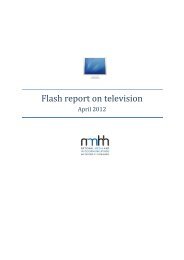The Hungarian Communications Market Developments and ...
The Hungarian Communications Market Developments and ...
The Hungarian Communications Market Developments and ...
You also want an ePaper? Increase the reach of your titles
YUMPU automatically turns print PDFs into web optimized ePapers that Google loves.
10 11<br />
Key areas of regulation for the period between 2008 <strong>and</strong> 2010<br />
NHH’s strategy has identified two key areas of regulation for the<br />
period between 2008 <strong>and</strong> 2010: the liberalisation of spectrum usage<br />
<strong>and</strong> the challenges related to the development of next generation<br />
networks (NGN).<br />
<strong>The</strong> objective of the liberalisation of spectrum usage is to achieve<br />
a more optimal usage of available frequency b<strong>and</strong>s, which currently<br />
is a scarce resource, <strong>and</strong> thereby to promote both competition in infrastructure<br />
<strong>and</strong> market development. <strong>The</strong> Authority wishes to realize<br />
these goals through the licensing of spectrum trading, i.e. promotion<br />
of the development of secondary trading, as well as through easing<br />
the licensing procedure, opening further license-exempt b<strong>and</strong>s, <strong>and</strong><br />
enabling free usage of the technology/service selected in the given<br />
frequency b<strong>and</strong>s.<br />
<strong>The</strong> regulatory tasks connected the secondary spectrum trading<br />
include definition of ownership rights, meeting the increasing<br />
need for interference management, <strong>and</strong> the coordination of market<br />
information.<br />
<strong>The</strong> term Next Generation Networks st<strong>and</strong>s for a currently evolving<br />
packet-switched transmission-based new network system that<br />
enables the support of several simultaneous broadb<strong>and</strong> services of<br />
guaranteed quality, while enabling service provision <strong>and</strong> transmission<br />
functions independently of each other. It offers unrestricted<br />
access to different service providers for users <strong>and</strong>, at the same<br />
time, it supports generalized mobility, which extends to all services<br />
requested by users.<br />
NGN may provide a potential drive for increasing competition at<br />
service <strong>and</strong> application levels, prerequisite of which is, however, that<br />
the NGN owner uses open st<strong>and</strong>ards. <strong>The</strong> Authority’s intention is to<br />
keep supporting this.<br />
<strong>The</strong> Authority considers to be a critical task to adapt the means for<br />
service competition to the NGN infrastructure. This will be required<br />
since, in the NGN network topology, the location of the last active<br />
equipment in the fixed network will change, which will result in a<br />
change in the possibility of co-location, <strong>and</strong> thus in the way of meeting<br />
unbundling <strong>and</strong> interconnection obligations.<br />
A number of other changes forecast the risk of incumbent service<br />
providers’ applying delaying tactics, which may present obstacles to<br />
the practical realisation of service competition for years. <strong>The</strong>refore,<br />
the Authority’s goal is to prepare in time for the technical, legal <strong>and</strong><br />
financial adaptation of the applicable regulatory instruments with<br />
reference to NGN.<br />
Nevertheless, by laying down the framework of NGN regulation<br />
ahead of time, the Authority’s goal is to minimize the regulatory risk<br />
of investment required for setting up the NGN <strong>and</strong> to ensure predictability<br />
for market players in general.


